1. Your favorite mutant?

Who’s your favorite mutant? Godzilla? The Hulk? Spiderman? X-men? The Fantastic Four? The Teenage Mutant Ninja Turtles?
In popular culture, mutations produce monsters and superheroes. In biology, mutations are important in both negative and positive ways. On the negative side, mutations cause damage that can lead to genetic defects and cancer. On the positive side, mutations are the ultimate source of the variation that makes evolution possible.
2. What is a mutation?
A mutation is a random change in genetic information. That change can involve
- Changes in a nucleotide sequence – the sequence of As Ts, Cs, and Gs that make up DNA or RNA.
- Larger-scale changes involving parts of chromosomes, or entire chromosomes.
While our focus below will be on genetic changes in organisms, note that changes in the DNA or RNA of viruses are important drivers of virus evolution. The SARS-CoV-2 variants (including alpha, beta, delta, and omicron) that have driven the COVID-19 pandemic all stem from mutations in the virus’s genome which changed the virus’s structure, making the virus more difficult for our immune systems to recognize and defend against.
3. A mutation case study: sickle cell anemia
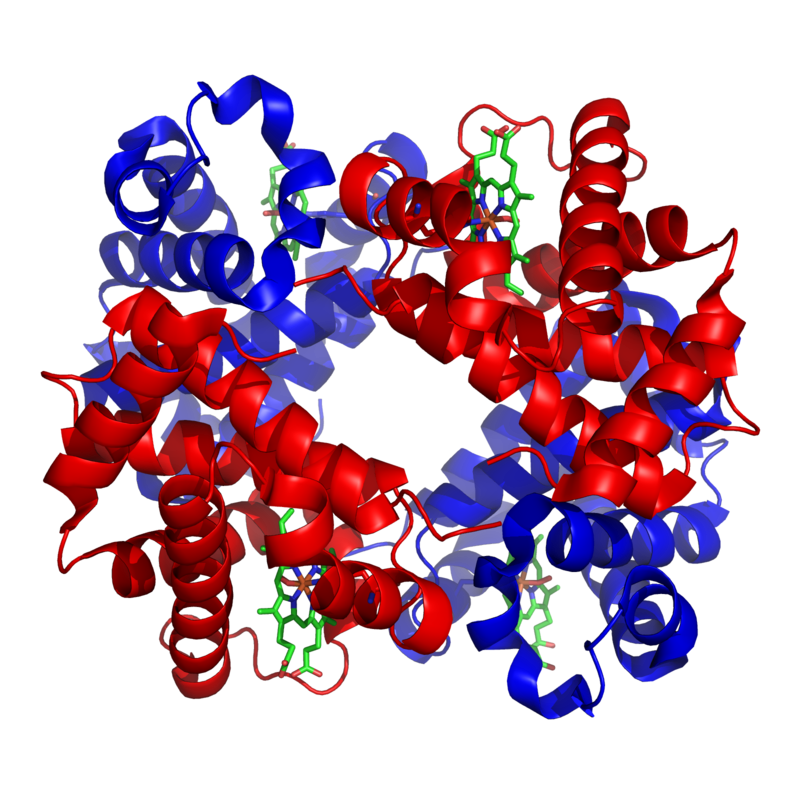
Examine the nucleotide sequence below. It’s part of the sequence that codes for hemoglobin (shown on the left). Hemoglobin is the protein that carries oxygen in the red blood cells of all vertebrates, and many invertebrates as well.
|
1 |
2 |
3 |
4 |
5 |
6 |
7 |
8 |
9 |
10 |
11 |
12 |
13 |
|
| DNA Nucleotides | ATG | GTG | CAC | CTG | ACT | CCT | GAG | GAG | AAG | TCT | GCC | GTT | ACT |
| Amino Acid | START | Val | His | Leu | Thr | Pro | Glu | Glu | Lys | Ser | Ala | Val | Thr |
The As, Ts, Cs, and Gs on the row labeled “DNA nucleotides” represent the nitrogenous bases that carry genetic information in DNA. The three letters on the amino acid row represent one of the twenty amino acids, or some genetic code “punctuation,” such as “start.” The numbers on top organize the nucleotides into triplets, reflecting the way that the genetic code uses groups of three nucleotides to code for one amino acid. The 13 triplets shown above code for the start of hemoglobin.
In genetics, the most common phenotype is referred to as the “wild type.” The sequence you looked at above was for “wild type” hemoglobin. Now, compare that sequence (shown again below) to the mutated hemoglobin sequence immediately below it. To make the difference easy to find, the mutated nucleotide is highlighted in red.
Original (wild type) Sequence for Hemoglobin
| WILD TYPE |
1 |
2 |
3 |
4 |
5 |
6 |
7 |
8 |
9 |
10 |
11 |
12 |
13 |
| DNA Nucleotides | ATG | GTG | CAC | CTG | ACT | CCT | GAG | GAG | AAG | TCT | GCC | GTT | ACT |
| Amino Acid | START | Val | His | Leu | Thr | Pro | Glu | Glu | Lys | Ser | Ala | Val | Thr |
Mutated Sequence for Hemoglobin
| MUTANT |
1 |
2 |
3 |
4 |
5 |
6 |
7 |
8 |
9 |
10 |
11 |
12 |
13 |
| DNA Nucleotides | ATG | GTG | CAC | CTG | ACT | CCT | GTG | GAG | AAG | TCT | GCC | GTT | ACT |
| Amino Acid | START | Val | His | Leu | Thr | Pro | Val | Glu | Lys | Ser | Ala | Val | Thr |
It doesn’t seem like much: just one nucleotide in the 7th triplet, where the DNA triplet GAG is changed to GTG. However, that one change results in the 7th amino acid being valine (Val) instead of glutamic acid (Glu, also known as glutamate).
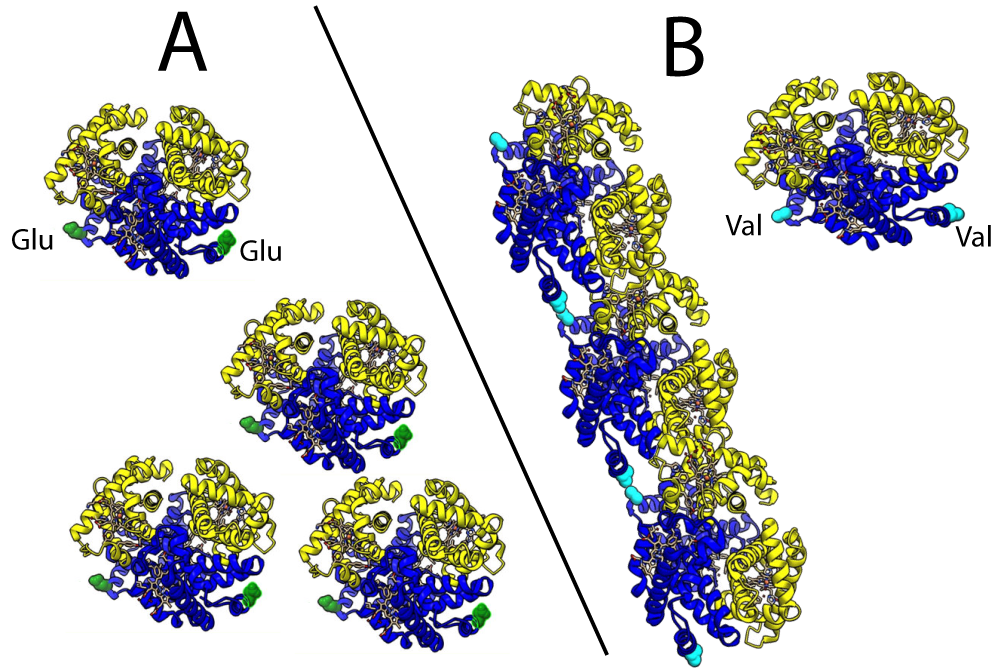
As you’ll remember from our module on proteins, amino acids fall into one of four groups, based on the chemistry of their side chain. Because valine is a non-polar amino acid and glutamic acid is ionic, the substitution changes hemoglobin’s chemical and physical properties.
Normally, hemoglobin molecules ignore one another (“A,” at right). However, the mutation causes adjacent mutated hemoglobin molecules, whenever they’re in a low-oxygen environment, to weakly bond with one another, forming elongated fibers (“B,” at right).
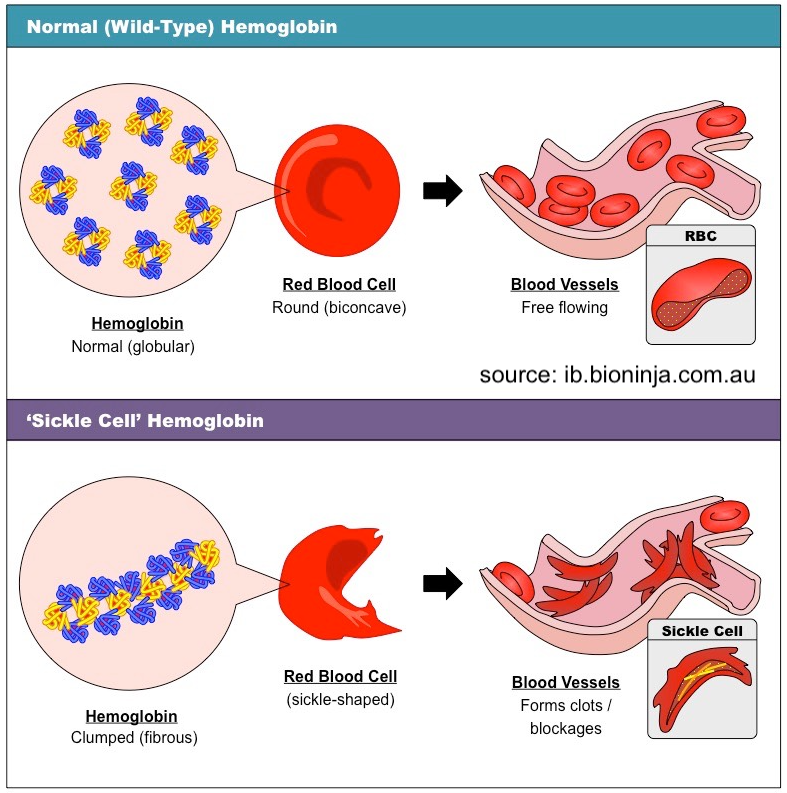
You can see the consequences for red blood cells in the diagram on the left. The normal, wild-type hemoglobin allows red blood cells to maintain their smooth shape, enabling them to easily flow through even the smallest blood vessels.
By contrast, the mutated hemoglobin, whenever exposed to a low oxygen environment, forms elongated fibers. When would this happen? During any activity such as running, climbing stairs, or any other kind of exertion. This, in turn, changes the shape of the red blood cells. Instead of smooth and roughly doughnut-shaped, red blood cells become spiky and sickle-shaped.
This shape causes them to clog up in small blood vessels, preventing blood from flowing to tissues downstream of the clog. Without adequate blood flow, the tissues on the other side of the blockage suffer damage, mostly from oxygen deprivation. This damage is associated with debilitating pain, a condition referred to as a “pain episode” or “pain crisis.”
A few more points about sickle cell anemia. The first is that you only have the full-blown condition if you’re unlucky enough to inherit the mutation through both your mother and your father. In other words, you have to inherit two genes to have sickled blood cells.
In genetics, gene variants are called alleles. In the diagram below, the mutated allele for sickle cell hemoglobin is represented by HbS. The allele for normal hemoglobin is represented by HbA. To inherit sickle cell anemia, both of your parents need to have one normal allele and one mutant allele (represented as HbA|HbS). From there, the laws of probability take over. Every child of such a union has a one-in-four chance of inheriting two mutant alleles and thus having the disease. That’s the child at the bottom right. The two children in the middle are like their parents: they’ve inherited only one mutated allele. As a result, their red blood cells are, for the most part, phenotypically normal. They’ll mostly have the smooth shape shown in the upper part of the diagram. The child on the left has two normal alleles.
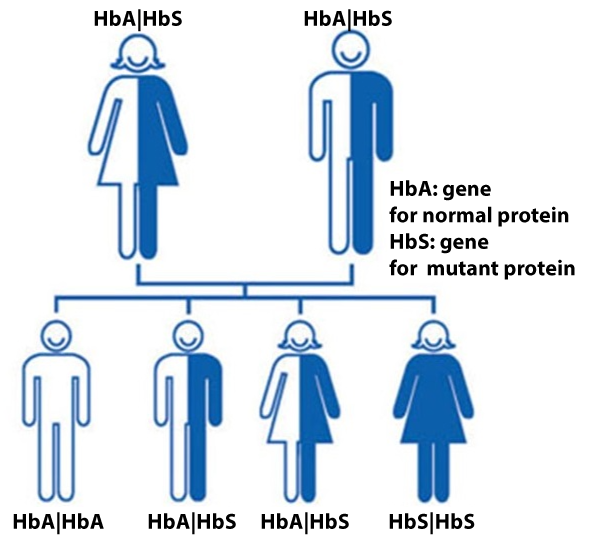
Note that having one sickle cell allele and one normal allele is not equivalent to having two normal alleles (like the HbA|HbA child on the far left). If you inherit one copy of the sickle cell mutation, it can be an evolutionary advantage. How? Because having one copy of the sickle cell mutation gives you resistance to the parasite that causes the blood disease malaria. You get resistance without suffering the symptoms of sickle cell disease.
That explains why many people in areas where malaria is common possess the gene. The evolutionary cost of possibly having a child with two copies of the gene is outweighed by the evolutionary advantage of having a child with one copy of the gene (whose chance for survival will be higher than a child with no copies of the gene). We’ll look at this in more detail when we study population genetics.
Medical treatment for sickle cell anemia has improved significantly during the last generation. In addition, sickle cell anemia is a primary target of new genetic therapies that might make curing sickle cell a possibility in the near future (the link goes to an article in the NY Times, September 2021, about one such recent cure)
4. Mutations Quiz 1: Sickle Cell
Let’s pull all of this together with a short quiz.
[qwiz qrecord_id=”sciencemusicvideosMeister1961-Mutation Quiz 1 (v2.0)”]
[h]Mutation Quiz 1 (Sickle Cell)
[i]
[q] A mutation is a [hangman] change in [hangman] information.
[c]IHJhbmRvbQ==[Qq]
[f]IEdvb2Qh[Qq]
[c]IGdlbmV0aWM=[Qq]
[f]IEdyZWF0IQ==[Qq]
[q] In a cell, mutations occur in the cell’s genetic material, which is made of [hangman]. In certain viruses, mutations can also occur in [hangman].
[c]IEROQQ==[Qq]
[f]IEdyZWF0IQ==[Qq]
[c]IFJOQQ==[Qq]
[f]IENvcnJlY3Qh[Qq]
[q multiple_choice=”true”] In the diagram below, which letter shows hemoglobin interacting in a way that leads to sickle cell anemia?
[c]IEE=[Qq]
[f]IE5vLiAmIzgyMjA7QSYjODIyMTsgc2hvd3Mgbm9ybWFsIGhlbW9nbG9iaW4gbW9sZWN1bGVzLCB3aGljaCBkb24mIzgyMTc7dCBpbnRlcmFjdCB3aXRoIG9uZSBhbm90aGVyLg==[Qq]
[c]IE I=[Qq]
[f]IEV4Y2VsbGVudC4gQmUgc2hvd3MgaGVtb2dsb2JpbiBtb2xlY3VsZXMgZm9ybWluZyB0aGUgZmliZXJzIHRoYXQgY2F1c2Ugc2lja2xpbmcu[Qq]
[q multiple_choice=”true”] In the gene for hemoglobin, how many nucleotides need to be mutated in to bring about sickle cell anemia.
[c]ID E=[Qq]
[f]IEV4YWN0bHkuIEp1c3QgYSBzaW5nbGUgbXV0YXRpb24gY2FuIGxlYWQgdG8gdGhlIGFtaW5vIGFjaWQgc3Vic3RpdHV0aW9uIHRoYXQgY2F1c2VzIHNpY2tsZSBjZWxsIGFuZW1pYS4=[Qq]
[c]IDI=[Qq]
[f]IE5vLiBTdHVkeSB0aGUgZGlhZ3JhbSBiZWxvdy4gSG93IG1hbnkgY2hhbmdlcyBkbyB5b3Ugc2VlPw==
Cg==[Qq]
[c]IDM=[Qq]
[f]IE5vLiBTdHVkeSB0aGUgZGlhZ3JhbSBiZWxvdy4gSG93IG1hbnkgY2hhbmdlcyBkbyB5b3Ugc2VlPw==
Cg==[Qq]
[q labels=”top”]
[l]blocked
[fx] No. Please try again.
[f*] Great!
[l]fibrous
[fx] No, that’s not correct. Please try again.
[f*] Good!
[l]free flowing
[fx] No. Please try again.
[f*] Good!
[l]globular
[fx] No, that’s not correct. Please try again.
[f*] Excellent!
[l]sickled
[fx] No, that’s not correct. Please try again.
[f*] Correct!
[l]smooth
[fx] No, that’s not correct. Please try again.
[f*] Correct!
[l]wild type
[fx] No. Please try again.
[f*] Excellent!
[l]mutant
[fx] No, that’s not correct. Please try again.
[f*] Good!
[q labels = “top”]Here are some lyrics from my “DNA Rap”. Try filling in the blanks.
Hundreds of bases spell one ______________ piece
Hundreds of A’s, G’s, ___, and Cs
The gene starts CAC-GTG-CAC
Then TGA-GGA-CTC-CTC
The key is these bases are ______________
For hemoglobin’s function and conformation
Hundreds of bases, in a predetermined ________
A single change brings on a major disorder
Change T to A in one _________ spot
This little point ____________ might not seem like a lot
Thymine to Adenine might not seem that big to ya’
But baby that’s the cause of ________ cell anemia!
[l]hemoglobin
[f*] Good!
[fx] No, that’s not correct. Please try again.
[l]information
[f*] Correct!
[fx] No. Please try again.
[l]mutation
[f*] Great!
[fx] No, that’s not correct. Please try again.
[l]order
[f*] Correct!
[fx] No, that’s not correct. Please try again.
[l]sickle
[f*] Correct!
[fx] No. Please try again.
[l]single
[f*] Excellent!
[fx] No, that’s not correct. Please try again.
[l]Ts
[f*] Excellent!
[fx] No. Please try again.
[/qwiz]
5. Somatic vs. Germ Line Mutations

The sickle cell mutation discussed above is an inherited mutation. If you’re unlucky enough to have sickle cell anemia, it’s because you inherited a mutant allele from both of your parents.
Mutations that you can inherit are known as germ-line mutations. The genetic information for these mutations can get passed on through sperm or egg cells to the next generation. That means that these mutated alleles need to be present in the germ cells in a male’s testes or a female’s ovaries that create sperm cells or egg cells. If the resulting sperm or egg cells contain the mutated gene, then the offspring that these sex cells give rise to will have the mutated gene in every cell of their body, including their germ cells.
In the left column in the diagram on the left, only 50% of the gametes (sex cells) possess the germ-line mutation. Why only 50%? It’s all about the laws of probability, a topic that’s covered in our tutorials about meiosis (the cell division process during which gametes get made).
Germ-line mutations are often bad, but they can also be good. As we’ve seen, in the case of sickle cell anemia, there are both disadvantages (disease) and advantages (resistance to malaria). In other genetic disorders, such as the lung disease cystic fibrosis or the neurological disease Tay Sachs, the effect seems to be wholly bad. But keep in mind that germline mutations are how new genes enter a population’s gene pool. They’re an important source of genetic variation, which is the raw material that makes evolutionary adaptation possible. Jump down to the final section of this tutorial to learn about a few more mutations that provide a clear survival advantage.
Somatic mutations arise in body cells. What’s a body cell? A cell that’s not a germ cell. Your liver cells are somatic cells. So are the cells in your skin, your lungs, your pancreas, your heart, and your brain.
Whereas germ-line mutations have (potentially) a long future ahead of them, somatic mutations only affect the organism where they arise. Somatic mutations don’t get transmitted through sperm or egg cells. Their effects are almost always bad: cancers arise from somatic mutations.

There is an exception to this idea that somatic mutations die when the organism they originate in dies. Many multicellular organisms reproduce asexually by budding off parts of themselves. Strawberry plants, for example, can reproduce asexually by putting out horizontal stems called runners. These runners, indicated by the white arrows in the photograph, can produce roots and an entirely new plant. A mutation in the runner (or the tissue that produced the runner) would be passed on to the offspring.
6. Types of Mutations
In the discussion that follows below, we’ll only be looking at mutations in DNA (or RNA). Large-scale mutations that involve alterations of hundreds of genes (or more) on one or more chromosomes are also possible. We’ll discuss these in modules related to genetics.
The smallest possible mutation is a point mutation. As the term indicates, a point mutation occurs at a single point in a nucleotide sequence.
The mutation that causes sickle cell anemia is a point mutation.
Because it involves substituting adenine for thymine, this type of point mutation is known as a substitution mutation. And because it results in a change in the amino acid sequence, it’s also called a missense mutation.
Here’s another point mutation: 
Like the missense mutation above, this is also a substitution. But note that while the DNA and the RNA are different, the amino acid coded for by the second triplet (proline) doesn’t change. Why not? Because the genetic code is redundant. If you code out the RNA, you’ll see that both CCA and CCG code for the same amino acid.

Mutations that do not affect the resulting protein are called silent mutations. Because of how the genetic code works, they most commonly occur in the third nucleotide in a DNA-coding triplet.
Here’s yet another possibility:
In this case, the substitution of an A for a C in the 1st letter of the third DNA triplet led the mRNA to code for a stop signal. Instead of another amino acid, the codon UAG codes for a release factor, leading to the termination of protein synthesis.

When a mutation results in the substitution of a stop codon for an amino acid, it’s called a nonsense mutation.
In addition to substitutions, point mutations can involve nucleotide insertions and deletions. These mutations cause extensive missense. To see why, let’s switch from nucleotides to an English sentence, one in which each word is three letters long. Instead of using spaces to separate the words, I’m using this character: “|.”
T H E|C A T|A T E | T H E |F A T| R A T.
Why does each word have 3 letters? It’s because the genetic code is written in 3-letter triplets, which get transcribed into 3-letter codons, which get translated into amino acids.
Now imagine deleting the “H” in the first word, “THE.” Because of how the genetic code is read, we need to keep on dividing the sentence into words with three letters. Here’s what we get.
T H C |A T A|T E T |H E F |A T R |A T
Except for the “AT” at the end, there’s not a single word that makes sense. The sentence as a whole is gibberish. An insertion would similarly cause extensive missense.
The key idea here is that genes have a reading frame: a set division of nucleotides into groups of three. Insertions or deletions change the reading frame and are called frameshift mutations.

If that explanation of a frameshift mutation doesn’t click for you, try this experiment. Put your fingers on your computer keyboard in the regular position, as shown in the image on the left. Now slide both of your hands over one key to the right: your right index finger will be on “G.” Your left index finger will be on “K.” Close your eyes, and type “I love biology.” You’ll type “O ;pbr nop;phu.” That’s a frameshift typing error. Extensive missense, with some nonsense (the punctuation marks).
7. How mutations arise
Mutations can occur for several reasons.
7a. Mistakes made during nucleic acid replication.
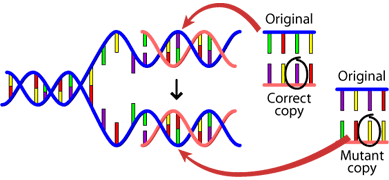 Replication of genetic information is one of the core processes shared by all living beings. But no replication process is perfect. Mistakes in replication are one source of mutation.
Replication of genetic information is one of the core processes shared by all living beings. But no replication process is perfect. Mistakes in replication are one source of mutation.
Let’s start by considering how frequently this occurs in our species, Homo sapiens. Each of us inherits two sets of the human genome: one from our mother, and one from our father. Each set consists of 3.1 billion nucleotides. That means that each time our cells divide, DNA consisting of 6.2 billion nucleotides needs to be accurately replicated.
A variety of DNA proofreading mechanisms help ensure that our DNA replicates with extremely high fidelity. The error rate may be as low as one in ten billion (see Nature, Scitable). But even with that level of accuracy, mutations are bound to occur during the trillions of cell divisions that occur during a person’s life.
Now think about bacteria. The genome of a bacterial cell like E. coli is much smaller than ours, with a total of about 4.5 million base pairs. But E. coli cells, when grown in optimal conditions, can replicate once every 20 minutes. Consequently, in any population of E. coli (or any other type of bacteria), a considerable number of individual cells can have mutated genes.
Finally, consider viruses. Viruses exploit the replication machinery of their hosts. But during viral replication, the proofreading mechanisms which maintain the accuracy of DNA replication in cells are not used. As a result, the number of viral mutants resulting from each replication cycle is much higher than the mutation rate in cells. In DNA viruses, the mutation rate is between 1 in 100,000,000 to 1 in 1,000,000. In RNA viruses, the range is from 1 in 1,000,000 to 1 in 10,000 (source). Note that SARS-CoV-2 is an RNA virus, which explains the emergence of mutant viral strains during the COVID-19 pandemic.
7b. Mutagens
Mutagens are factors in the environment that can cause mutations. The word is easy to remember: it’s short for “mutation generator.”
One type of mutagen is ionizing radiation. Ionizing radiation is the kind that can disrupt atoms by removing electrons or protons (changing neutral atoms into ions). These disruptions can break DNA altogether, or alter the nitrogenous bases in a way that leads to errors when DNA is replicated.
One type of ionizing radiation is high-energy electromagnetic energy. This includes ultraviolet radiation, X-rays, and gamma rays. These are all types of electromagnetic energy that have more energy than light, as shown below.

The mutagenic nature of this kind of energy is why you wear a lead blanket when you get a diagnostic X-ray from a doctor. While the X-rays help visualize what’s going on inside a specific part of your body, the lead blanket protects the rest of your body from unnecessary radiation exposure.
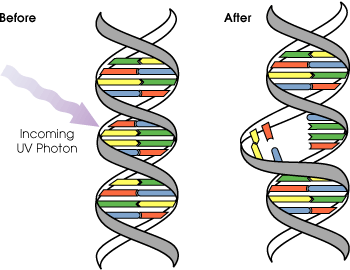 Similarly, the reason for wearing sunscreen is to protect our skin from ultraviolet light (also referred to as u.v. light). When u.v. light strikes a section of DNA that has two adjacent thymine nucleotides (shown in yellow in the diagram to the left), the energy can chemically change the thymines in a way that causes them to fuse. Sometimes DNA repair enzymes can fix this damage. Other times mutations result.
Similarly, the reason for wearing sunscreen is to protect our skin from ultraviolet light (also referred to as u.v. light). When u.v. light strikes a section of DNA that has two adjacent thymine nucleotides (shown in yellow in the diagram to the left), the energy can chemically change the thymines in a way that causes them to fuse. Sometimes DNA repair enzymes can fix this damage. Other times mutations result.
Here’s what the American Cancer Society says about the link between ultraviolet radiation and cancer.
Most skin cancers are a result of exposure to UV rays in sunlight. Both basal cell and squamous cell cancers (the most common types of skin cancer) tend to be found on sun-exposed parts of the body, and their occurrence is typically related to lifetime sun exposure. The risk of melanoma, a more serious but less common type of skin cancer, is also related to sun exposure, although perhaps not as strongly. Skin cancer has also been linked to exposure to some man-made sources of UV rays.
Emissions from the decay of radioactive atoms can also cause mutation. When radioactive elements like uranium break down, they emit both ionizing radiation and particles. Both the energy and the particles can disrupt DNA, causing mutation. The breakdown of naturally occurring uranium, for example, can lead to the production of radon gas, which can be inhaled. Inside your lungs, the radon continues to break down, releasing energy and particles. Radon exposure, according to the American Cancer Society, is the second leading cause of lung cancer in the United States.
Chemical mutagens are substances that can interact with DNA in a way that can lead to mutation. Up to 70 such mutagens can be found in tobacco smoke. Sodium nitrite, a commonly used preservative in processed meats, can be converted during digestion into nitrosamines, which are associated with cancer of the stomach and esophagus.
You’ve probably noticed that this discussion about mutagens has frequently mentioned cancer. There’s a special word for mutations that induce cancer: carcinogen. Most mutagens are also carcinogens (and vice versa).
8. Mutations Quiz 2
[qwiz style= “width:650px” qrecord_id=”sciencemusicvideosMeister1961-Mutations Quiz 2 (v2.0)”]
[h] Mutations Quiz 2
[i]
[q] A mutation that can be inherited must be a mutation in the[hangman] line. By contrast, a mutation that arises in lung, skin, or muscle tissue would be a [hangman] mutation.
[c]IGdlcm0=[Qq]
[f]IENvcnJlY3Qh[Qq]
[c]IHNvbWF0aWM=[Qq]
[f]IEdvb2Qh[Qq]
[q Labels=”top”]Label the diagram below.
[l]germ-line
[f*] Great!
[fx] No. Please try again.
[l]somatic
[f*] Excellent!
[fx] No, that’s not correct. Please try again.
[q] The type of mutation that doesn’t get passed on to the next generation is a [hangman] mutation.
[c]IHNvbWF0aWM=[Qq]
[f]IENvcnJlY3Qh[Qq]
[q multiple_choice=”true”] A mutation in which one DNA nucleotide is swapped for another is a __________ mutation.
[c]IHN1YnN0aX R1dGlvbg==[Qq]
[f]IEFic29sdXRlbHkuIEEgbXV0YXRpb24gaW4gd2hpY2ggb25lIG51Y2xlb3RpZGUgaXMgc3dhcHBlZCBmb3IgYW5vdGhlciBpcyBhIHN1YnN0aXR1dGlvbiBtdXRhdGlvbi4=[Qq]
[c]IE1pc3NlbnNl[Qq]
[f]IE5vdCBuZWNlc3NhcmlseS4gVGhlIG11dGF0aW9uIHdvdWxkIG9ubHkgYmUgbWlzc2Vuc2UgaWYgaXQgcmVzdWx0ZWQgaW4gYW4gaW5jb3JyZWN0IGFtaW5vIGFjaWQgYmVpbmcgaW5jb3Jwb3JhdGVkIGludG8gdGhlIHByb3RlaW4gdGhhdCB0aGUgRE5BIGNvZGVzIGZvci4=[Qq]
[c]IG5vbnNlbnNl[Qq]
[f]IE5vdCBuZWNlc3NhcmlseS4gQSBub25zZW5zZSBtdXRhdGlvbiBvbmx5IHJlc3VsdHMgaWYgdGhlIG11dGF0aW9uIGNoYW5nZXMgdGhlIGNvZG9uIGluIHN1Y2ggYSB3YXkgdGhhdCBpdCBzdWJzdGl0dXRlcyBhIFNUT1AgY29kb24gZm9yIGFuIGFtaW5vIGFjaWQgaW4gdGhlIHdpbGQtdHlwZSBwcm90ZWluLg==[Qq]
[c]IGZyYW1lc2hpZnQ=[Qq]
[f]IE5vLiBBIGZyYW1lc2hpZnQgbXV0YXRpb24gcmVxdWlyZXMgdGhhdCBhIG51Y2xlb3RpZGUgYmUgaW5zZXJ0ZWQgb3IgZGVsZXRlZCBpbiBhIHdheSB0aGF0IGNoYW5nZXMgdGhlIHJlYWRpbmcgZnJhbWUu[Qq]
[q multiple_choice=”true”] The image below shows what kind of mutation?
[c]IHN1YnN0aXR1dGlvbg==[Qq]
[f]IE5vLiBIZXJlJiM4MjE3O3MgYSBoaW50LiBOb3RlIGhvdyBhbG1vc3QgYWxsIHRoZSBudWNsZW90aWRlIGJhc2VzIGFyZSB0aGUgc2FtZS4gVGhleSYjODIxNztyZSBqdXN0IGJlaW5nIHJlYWQgZGlmZmVyZW50bHku[Qq]
[c]IE1pc3NlbnNl[Qq]
[f]IE5vdCBxdWl0ZS4gVGhlcmUgaXMgZXh0ZW5zaXZlIG1pc3NlbnNlLiBCdXQgdGhlcmUmIzgyMTc7cyBhIGJldHRlciBhbnN3ZXIu
Cg==SGVyZSYjODIxNztzIGEgaGludDogTm90ZSBob3cgYWxtb3N0IGFsbCB0aGUgbnVjbGVvdGlkZSBiYXNlcyBhcmUgdGhlIHNhbWUuIFRoZXkmIzgyMTc7cmUganVzdCBiZWluZyByZWFkIGRpZmZlcmVudGx5Lg==[Qq]
[c]IG5vbnNlbnNl[Qq]
[f]IE5vLiBBIG5vbnNlbnNlIG11dGF0aW9uIG9ubHkgcmVzdWx0cyBpZiB0aGUgbXV0YXRpb24gY2hhbmdlcyB0aGUgY29kb24gaW4gc3VjaCBhIHdheSB0aGF0IGl0IHN1YnN0aXR1dGVzIGEgU1RPUCBjb2RvbiBmb3IgYW4gYW1pbm8gYWNpZCBpbiB0aGUgd2lsZC10eXBlIHByb3RlaW4uIFNvbWV0aGluZyBlbHNlIGhhcHBlbmVkIGhlcmUu[Qq]
[c]IGZyYW1l c2hpZnQ=[Qq]
[f]IEV4Y2VsbGVudC4gQSBmcmFtZXNoaWZ0IG11dGF0aW9uIHJlcXVpcmVzIHRoYXQgYSBudWNsZW90aWRlIGJlIGluc2VydGVkIG9yIGRlbGV0ZWQgaW4gYSB3YXkgdGhhdCBjaGFuZ2VzIHRoZSByZWFkaW5nIGZyYW1lLCB3aGljaCBpcyBleGFjdGx5IHdoYXQgaGFwcGVuZWQgaGVyZS4=[Qq]
[q multiple_choice=”true”] The best description for the mutation shown below would be a __________ mutation.
[c]IHN1YnN0aXR1dGlvbg==[Qq]
[f]IFRoZXJlIHdhcyBhIHN1YnN0aXR1dGlvbiwgYnV0IHRoZSByZXN1bHQgbWVhbnMgdGhhdCB0aGVyZSYjODIxNztzIGEgYmV0dGVyIGFuc3dlci4gTm90ZSB0aGF0IHRoZSByZXN1bHQgb2YgdGhpcyBtdXRhdGlvbiB3YXMgYSBzdWJzdGl0dXRpb24gb2YgYSBTVE9QIGNvZG9uIGZvciBvbmUgb2YgdGhlIGFtaW5vIGFjaWRzIGluIHRoZSB3aWxkLXR5cGUgcHJvdGVpbi4=[Qq]
[c]IE1pc3NlbnNl[Qq]
[f]IE5vdCBxdWl0ZS4gTm90ZSB0aGF0IHRoZSByZXN1bHQgb2YgdGhpcyBtdXRhdGlvbiB3YXMgYSBzdWJzdGl0dXRpb24gb2YgYSBTVE9QIGNvZG9uIGZvciBvbmUgb2YgdGhlIGFtaW5vIGFjaWRzIGluIHRoZSB3aWxkLXR5cGUgcHJvdGVpbi4=[Qq]
[c]IG5vbn NlbnNl[Qq]
[f]IE5pY2VseSBkb25lLiBBIG5vbnNlbnNlIG11dGF0aW9uIHJlc3VsdHMgaWYgdGhlIG11dGF0aW9uIGNoYW5nZXMgdGhlIGNvZG9uIGluIHN1Y2ggYSB3YXkgdGhhdCBpdCBzdWJzdGl0dXRlcyBhIFNUT1AgY29kb24gZm9yIGFuIGFtaW5vIGFjaWQgaW4gdGhlIHdpbGQtdHlwZSBwcm90ZWluLiBUaGF0JiM4MjE3O3MgZXhhY3RseSB3aGF0IGhhcHBlbnMgaGVyZS4=[Qq]
[c]IGZyYW1lc2hpZnQ=[Qq]
[f]IE5vLiBBIGZyYW1lc2hpZnQgbXV0YXRpb24gcmVxdWlyZXMgdGhhdCBhIG51Y2xlb3RpZGUgYmUgaW5zZXJ0ZWQgb3IgZGVsZXRlZCBpbiBhIHdheSB0aGF0IGNoYW5nZXMgdGhlIHJlYWRpbmcgZnJhbWUuIFNvbWV0aGluZyBlbHNlIGhhcHBlbmVkIGhlcmUu[Qq]
[q multiple_choice=”true”] The best description for the mutation shown below would be a __________ mutation.
[c]IE1pc3 NlbnNl[Qq]
[f]IFllcy4gVGhlIG11dGF0aW9uIGNoYW5nZWQgdGhlIGFtaW5vIGFjaWQsIG1ha2luZyB0aGlzIGEgbWlzc2Vuc2UgbXV0YXRpb24u[Qq]
[c]IG5vbnNlbnNl[Qq]
[f]IE5vLiBBIG5vbnNlbnNlIG11dGF0aW9uIHJlc3VsdHMgaWYgdGhlIG11dGF0aW9uIGNoYW5nZXMgdGhlIGNvZG9uIGluIHN1Y2ggYSB3YXkgdGhhdCBpdCBzdWJzdGl0dXRlcyBhIFNUT1AgY29kb24gZm9yIGFuIGFtaW5vIGFjaWQgaW4gdGhlIHdpbGQtdHlwZSBwcm90ZWluLg==[Qq]
[c]IGZyYW1lc2hpZnQ=[Qq]
[f]IE5vLiBBIGZyYW1lc2hpZnQgbXV0YXRpb24gcmVxdWlyZXMgdGhhdCBhIG51Y2xlb3RpZGUgYmUgaW5zZXJ0ZWQgb3IgZGVsZXRlZCBpbiBhIHdheSB0aGF0IGNoYW5nZXMgdGhlIHJlYWRpbmcgZnJhbWUuIFNvbWV0aGluZyBlbHNlIGhhcHBlbmVkIGhlcmUu[Qq]
[q]Compare each of the triplets below with the Wild type triplet, then describe each one.
[c]IHNpbGVudA==[Qq]
[f]IEdvb2Qh[Qq]
[c]IG5vbnNlbnNl[Qq]
[f]IEdvb2Qh[Qq]
[c]IG1pc3NlbnNl[Qq]
[f]IENvcnJlY3Qh[Qq]
[q multiple_choice=”true”] Which of the following forms of electromagnetic radiation is a known mutagen?
[c]IHJhZGlvIHdhdmVz[Qq]
[f]IE5vLiBSYWRpbyB3YXZlcyBhcmVuJiM4MjE3O3QgaW9uaXppbmcgcmFkaWF0aW9uIChiZWNhdXNlIHRoZXkgZG9uJiM4MjE3O3QgaGF2ZSBlbm91Z2ggZW5lcmd5KS4=[Qq]
[c]IEJsdWUgbGlnaHQgZnJvbSBhIHZpZGVvIG1vbml0b3I=[Qq]
[f]IE5vLiBWaXNpYmxlIGxpZ2h0IChzdWNoIGFzIGJsdWUgbGlnaHQpIGlzbiYjODIxNzt0IGlvbml6aW5nIHJhZGlhdGlvbiAoYmVjYXVzZSBpdCBkb2VzbiYjODIxNzt0IGhhdmUgZW5vdWdoIGVuZXJneSku[Qq]
[c]IFgtcm F5cw==[Qq]
[f]IFllcy4gWC1yYXlzIGFyZSBhIHR5cGUgb2YgaW9uaXppbmcgcmFkaWF0aW9uLg==[Qq]
[q multiple_choice=”true”] The type of radiation that is most associated with skin cancer is
[c]IHJlZCBsaWdodA==[Qq]
[f]IE5vLiBSZWQgbGlnaHQgZG9lc24mIzgyMTc7dCBoYXZlIGVub3VnaCBlbmVyZ3kgdG8gZGlzcnVwdCBETkEgKGl0JiM4MjE3O3Mgbm90IGlvbml6aW5nKS4=[Qq]
[c]IFJhZGlhdGlvbiBmcm9tIGNlbGwgcGhvbmVzLg==[Qq]
[f]IE5vLiBBY2NvcmRpbmcgdG8gdGhlIFVTIEZvb2QgYW5kIERydWcgQWRtaW5pc3RyYXRpb24sIHRoZXJlJiM4MjE3O3Mgbm8gZXZpZGVuY2UgdGhhdCB0aGUgcmFkaW8gd2F2ZXMgdXNlZCBieSBjZWxsIHBob25lcyBjYXVzZSBhbnkgdHlwZSBvZiBjYW5jZXIu[Qq]
[c]IHVsdHJhLXZpb2xl dCByYWRpYXRpb24=[Qq]
[f]IFllcy4gRXhwb3N1cmUgdG8gdWx0cmF2aW9sZXQgcmFkaWF0aW9uIGlzIGFzc29jaWF0ZWQgd2l0aCBza2luIGNhbmNlci4=[Qq]
[q] A substance or type of energy that can cause mutation is known as a [hangman]. If that substance or energy can also cause cancer, it’s known as a [hangman].
[c]IG11dGFnZW4=[Qq]
[c]IGNhcmNpbm9nZW4=[Qq]
[q] A change in a nucleotide sequence of a gene is called a (n)
[c]IHRyYW5zZm9ybWF0aW9uLg==[Qq]
[c]IG11dGF0 aW9uLg==[Qq]
[c]IHJlY29tYmluYXRpb24=[Qq]
[f]IE5vLiBXaGlsZSDigJh0cmFuc2Zvcm1hdGlvbuKAmSBpcyByb3VnaGx5IHN5bm9ueW1vdXMgd2l0aCDigJhjaGFuZ2Us4oCZIHRoZXJl4oCZcyBhIGJldHRlciBtYXRjaCBmb3IgdGhlIGRlZmluaXRpb24gYWJvdmUuIEFkZGl0aW9uYWxseSwgdGhlcmXigJlzIGEgc3BlY2lhbCBiaW9sb2dpY2FsIGRlZmluaXRpb24gb2Yg4oCYdHJhbnNmb3JtYXRpb2464oCZIHB1dHRpbmcgbmV3IEROQSBpbnRvIGEgY2VsbC4gTmV4dCB0aW1lLCBjaG9vc2UgYW5vdGhlciB0ZXJtLg==[Qq]
[f]IFRoYXTigJlzIGNvcnJlY3QuIEEgbXV0YXRpb24gaXMgYSBjaGFuZ2UgaW4gdGhlIG51Y2xlb3RpZGUgc2VxdWVuY2Ugb2YgYSBnZW5lLg==[Qq]
[f]IFJlY29tYmluYXRpb24gZG9lcyBpbnZvbHZlIGNoYW5nZXMgaW4gRE5BLCBhcyBETkEgZnJvbSBkaWZmZXJlbnQgc291cmNlcyBpcyBtaXhlZCB0b2dldGhlci4gQnV0IHRoZXJl4oCZcyBhIGJldHRlciB0ZXJtIHRvIG1hdGNoIHRoZSBkZWZpbml0aW9uIGFib3ZlLg==[Qq]
[q]True or false? When the environment changes, a population will evolve new mutations so that it can adapt.
[c]IFRydWU=[Qq]
[c]IEZh bHNl[Qq]
[f]IE5vLiBNdXRhdGlvbnMgYXJlIHJhbmRvbS4gRXZvbHV0aW9uYXJ5IGFkYXB0YXRpb24gaXMgYWJvdXQgcHJldmlvdXNseSBleGlzdGluZyB2YXJpYXRpb25zIGJlaW5nIHNlbGVjdGVkIGJ5IHRoZSBlbnZpcm9ubWVudCwgYW5kIGFsbGVsZSBmcmVxdWVuY2llcyBzaGlmdGluZyBpbiByZXNwb25zZS4=[Qq]
[f]IFRoYXTigJlzIGNvcnJlY3QuIE11dGF0aW9ucyBhcmUgcmFuZG9tLiBFdm9sdXRpb25hcnkgYWRhcHRhdGlvbiBpcyBhYm91dCBwcmV2aW91c2x5IGV4aXN0aW5nIHZhcmlhdGlvbnMgYmVpbmcgc2VsZWN0ZWQgYnkgdGhlIGVudmlyb25tZW50LCBhbmQgYWxsZWxlIGZyZXF1ZW5jaWVzIHNoaWZ0aW5nIGluIHJlc3BvbnNlLg==
Cg==[Qq]
[q]A mutation causes a nucleotide sequence to change from
TGAGGTCTCCTC
to
TGAGGCCTCCTC
Both sequences code for the same amino acid sequence.
This type of mutation is known as a(n)
[c]IGluc2VydGlvbiBtdXRhdGlvbi4=[Qq]
[c]IGRlbGV0aW9uIG11dGF0aW9uLg==[Qq]
[c]IHNpbGVudCBt dXRhdGlvbi4=[Qq]
[c]IGZyYW1lc2hpZnQgbXV0YXRpb24u[Qq]
[f]IE5vLiBBbiBpbnNlcnRpb24gbXV0YXRpb24gd291bGQgYWRkIGEgbmV3IG51Y2xlb3RpZGUgc29tZXdoZXJlIGluIHRoZSBudWNsZW90aWRlIHNlcXVlbmNlLCBhbmQgcHVzaCBhbGwgdGhlIG90aGVyIG51Y2xlb3RpZGVzIG92ZXIgb25lIHBvc2l0aW9uLiBUaGUgbWFpbiBjb25zZXF1ZW5jZSBvZiB0aGlzIGlzIHRoYXQgaXQgY2hhbmdlcyB0aGUgcmVhZGluZyBmcmFtZSwgYW5kIGNoYW5nZXMgZXZlcnkgY29kb24gZG93bnN0cmVhbSBvZiB0aGUgbXV0YXRpb24uIE5leHQgdGltZSwgY2hvb3NlIGEgdHlwZSBvZiBtdXRhdGlvbiB3aXRoIGEgbGVzcyBkcmFzdGljIGVmZmVjdC4=[Qq]
[f]IE5vLiBBIGRlbGV0aW9uIG11dGF0aW9uIHdvdWxkIHJlbW92ZSBhIG51Y2xlb3RpZGUgc29tZXdoZXJlIGluIHRoZSBudWNsZW90aWRlIHNlcXVlbmNlLCBhbmQgcHVsbCBhbGwgdGhlIG90aGVyIG51Y2xlb3RpZGVzIG9uZSBwb3NpdGlvbiBmb3J3YXJkLiBUaGUgbWFpbiBjb25zZXF1ZW5jZSBvZiB0aGlzIGlzIHRoYXQgaXQgY2hhbmdlcyB0aGUgcmVhZGluZyBmcmFtZSwgYW5kIGNoYW5nZXMgZXZlcnkgY29kb24gZG93bnN0cmVhbSBvZiB0aGUgbXV0YXRpb24uIE5leHQgdGltZSwgY2hvb3NlIGEgdHlwZSBvZiBtdXRhdGlvbiB3aXRoIGEgbGVzcyBkcmFzdGljIGVmZmVjdC4=[Qq]
[f]IEV4YWN0bHkuIEEgc2lsZW50IG11dGF0aW9uIGNoYW5nZXMgdGhlIEROQSBidXQgZG9lc27igJl0IGNoYW5nZSB0aGUgYW1pbm8gYWNpZHMgdGhhdCB0aGUgc2VxdWVuY2UgaXMgY29kaW5nIGZvci4=[Qq]
[f]IEEgZnJhbWVzaGlmdCBtdXRhdGlvbiByZXN1bHRzIGZyb20gZWl0aGVyIGluc2VydGluZyBvciBkZWxldGluZyBhIGJhc2UuIFRoZXNlIGluc2VydGlvbnMgY2hhbmdlIHRoZSByZWFkaW5nIGZyYW1lIGR1cmluZyB0cmFuc2xhdGlvbiBhbmQgY2F1c2UgbWFueSBvZiB0aGUgYW1pbm8gYWNpZHMgaW4gdGhlIHByb3RlaW4gdGhhdCB0aGUgZ2VuZSBjb2RlcyBmb3IgdG8gYmUgY2hhbmdlZC4gSW4gdGhlIGV4YW1wbGUgYWJvdmUsIHdoYXQgd2UgaGF2ZSBpcyBhIHNpbXBsZSBzdWJzdGl0dXRpb246IG9uZSB0aGF0IGRvZXNu4oCZdCBjaGFuZ2UgZXZlbiBvbmUgYW1pbm8gYWNpZC4gQ2hvb3NlIGFub3RoZXIgYW5zd2VyIG5leHQgdGltZS4=
Cg==[Qq]
[q]What’s the most likely effect of a mutation that deletes one nucleotide near the start of a gene?
[c]IFRoZSBtdXRhdGlvbiB3aWxsIGNhdXNlIGEgc2luZ2xlIGFtaW5vIGFjaWQgdG8gYmUgY2hhbmdlZCBpbiB0aGUgcHJvdGVpbiB0aGF0IHRoaXMgZ2VuZSBjb2RlcyBmb3Iu[Qq]
[c]IFRoZSBtdXRhdGlvbiB3aWxsIGNhdXNlIGEgc2VyaWVzIG9mIGNoYW5nZXMg aW4gdGhlIGFtaW5vIGFjaWRzIHRoYXQgdGhlIGdlbmUgY29kZXMgZm9yLg==[Qq]
[c]IFRoZSBtdXRhdGlvbiB3aWxsIGNhdXNlIG5vIGNoYW5nZSBpbiB0aGUgcmVzdWx0aW5nIHByb3RlaW4u[Qq]
[f]IE5vLiBJZiBhIHNpbmdsZSBudWNsZW90aWRlIGlzIGRlbGV0ZWQgbmVhciB0aGUgc3RhcnQgb2YgYSBnZW5lLCB0aGVuIHRoZSDigJhyZWFkaW5nIGZyYW1l4oCZIGZvciBhbGwgc3Vic2VxdWVudCBjb2RvbnMgd2lsbCBiZSBzaGlmdGVkLiBBbG1vc3QgYWxsIHRoZSBjb2RvbnMgd2lsbCBiZSBpbmNvcnJlY3RseSByZWFkLCBjaGFuZ2luZyBtYW55IGFtaW5vIGFjaWRzIGluIHRoYXQgcHJvdGVpbi4=[Qq]
[f]IFllcy7CoCBJZiBhIHNpbmdsZSBudWNsZW90aWRlIGlzIGRlbGV0ZWQgbmVhciB0aGUgc3RhcnQgb2YgYSBnZW5lLCB0aGVuIHRoZSDigJhyZWFkaW5nIGZyYW1l4oCZIGZvciBhbGwgc3Vic2VxdWVudCBjb2RvbnMgd2lsbCBiZSBzaGlmdGVkLiBBbG1vc3QgYWxsIHRoZSBjb2RvbnMgd2lsbCBiZSBpbmNvcnJlY3RseSByZWFkLCByZXN1bHRpbmcgaW4gZXh0ZW5zaXZlIG1pc3NlbnNlLg==[Qq]
[f]IFRoYXTigJlzIG5vdCBjb3JyZWN0LiBJZiBhIHNpbmdsZSBudWNsZW90aWRlIGlzIGRlbGV0ZWQgbmVhciB0aGUgc3RhcnQgb2YgYSBnZW5lLCB0aGVuIHRoZSDigJhyZWFkaW5nIGZyYW1l4oCZIGZvciBhbGwgc3Vic2VxdWVudCBjb2RvbnMgd2lsbCBiZSBzaGlmdGVkLiBBbG1vc3QgYWxsIHRoZSBjb2RvbnMgd2lsbCBiZSBpbmNvcnJlY3RseSByZWFkLCBjaGFuZ2luZyBtYW55IGFtaW5vIGFjaWRzIGluIHRoYXQgcHJvdGVpbi4gSXQgbG9va3MgbGlrZSB5b3Ugd2VyZSB0aGlua2luZyBhYm91dCBhIOKAmHNpbGVudCBtdXRhdGlvbizigJkgd2hpY2ggaXMgd2hlbiBhIG11dGF0aW9uIGNoYW5nZXMgdGhlIEROQSwgYnV0IG5vdCB0aGUgcHJvdGVpbi4gVGhpcyBjYW4gaGFwcGVuIHdoZW4gb25lIG51Y2xlb3RpZGUgaXMgc3Vic3RpdHV0ZWQgZm9yIGFub3RoZXIsIGFuZCBpdCBoYXBwZW5zIGJlY2F1c2UgbWFueSBjb2RvbnMgYXJlIHN5bm9ueW1vdXMsIGFuZCBjb2RlIGZvciB0aGUgc2FtZSBhbWlubyBhY2lkLiBEZWxldGlvbnMsIGJ5IGNvbnRyYXN0LCBhcmUgcmFyZWx5IHNpbGVudC4=
Cg==[Qq]
[q]Insertion or deletion of a single nucleotide in a DNA sequence results in a
[c]IGZyYW1lc2hpZn QgbXV0YXRpb24u[Qq]
[c]IHNpbGVudCBtdXRhdGlvbi4=[Qq]
[c]IHBvaW50IG11dGF0aW9uIHRoYXQgZG9lc27igJl0IGNoYW5nZSB0aGUgcmVhZGluZyBmcmFtZS4=[Qq]
[f]IFRlcnJpZmljISBJbnNlcnRpb25zIG9yIGRlbGV0aW9ucyBpbiB0aGUgbnVjbGVvdGlkZSBzZXF1ZW5jZSBlaXRoZXIgcHVzaCBhbGwgdGhlIG51Y2xlb3RpZGVzIGRvd24gb3IgcHVsbCB0aGVtIGFsbCBmb3J3YXJkLiBUaGUgbWFpbiBjb25zZXF1ZW5jZSBvZiB0aGlzIGlzIHRoYXQgaXQgY2hhbmdlcyB0aGUgcmVhZGluZyBmcmFtZSwgYW5kIGNoYW5nZXMgZXZlcnkgY29kb24gZG93bnN0cmVhbSBvZiB0aGUgbXV0YXRpb24u[Qq]
[f]IE5vLiBBIHNpbGVudCBtdXRhdGlvbiBjaGFuZ2VzIHRoZSBETkEsIHdpdGhvdXQgY2hhbmdpbmcgYW55IG9mIHRoZSBhbWlubyBhY2lkcyB0aGUgZ2VuZSBjb2RlcyBmb3IuIEluc2VydGlvbnMgb3IgZGVsZXRpb25zIGluIHRoZSBudWNsZW90aWRlIHNlcXVlbmNlIGVpdGhlciBwdXNoIGFsbCB0aGUgbnVjbGVvdGlkZXMgZG93biBvciBwdWxsIHRoZW0gYWxsIGZvcndhcmQuIFRoZSBtYWluIGNvbnNlcXVlbmNlIG9mIHRoaXMgaXMgdGhhdCBpdCBjaGFuZ2VzIHRoZSByZWFkaW5nIGZyYW1lLCBhbmQgY2hhbmdlcyBldmVyeSBjb2RvbiBkb3duc3RyZWFtIG9mIHRoZSBtdXRhdGlvbi4gU2VlIGlmIHlvdSBjYW4gZmluZCBhIGNob2ljZSB0aGF0LCBpbiBhIHNpbmdsZSB3b3JkLCBjYXB0dXJlcyB3aGF0IGhhcHBlbnMgd2l0aCBpbnNlcnRpb25zIG9yIGRlbGV0aW9ucy4=[Qq]
[f]IE5vLiBUaGUga2V5IHBvaW50IGhlcmUgaXMgdGhhdCBpbnNlcnRpbmcgb3IgZGVsZXRpbmcgYSBudWNsZW90aWRlIGZyb20gYSBETkEgc2VxdWVuY2Ugc2hpZnRzIGV2ZXJ5IG51Y2xlb3RpZGUgZm9yd2FyZCBvciBiYWNrd2FyZC4gVGhpcyBkb2VzIGNoYW5nZSB0aGUgcmVhZGluZyBmcmFtZS4gTmV4dCB0aW1lLCBjaG9vc2UgYW5vdGhlciBhbnN3ZXIu
Cg==[Qq]
[q ]Which type of mutation is most likely to be acted upon by natural selection?
[c]IEEgc2lsZW50IG11dGF0aW9uICh3aGljaCBvbmx5IGNoYW5nZXMgdGhlIEROQSk=[Qq]
[c]IEFuIGFjdGl2ZSBtdXRhdGlvbiAod2hpY2ggY2hhbmdlcyB0aGUg RE5BLCBhbmQgdGhlIHByb3RlaW4gdGhlIEROQSBjb2RlcyBmb3Ip[Qq]
[f]IE5vLiBTaWxlbnQgbXV0YXRpb25zIGRvIG5vdCBhZmZlY3QgYW4gb3JnYW5pc23igJlzIHBoZW5vdHlwZS4gU2luY2UgbmF0dXJhbCBzZWxlY3Rpb24gb25seSBhY3RzIG9uIHRoZSBwaGVub3R5cGUsIHNpbGVudCBtdXRhdGlvbiBjYW7igJl0IGJlIGFjdGVkIG9uIGJ5IG5hdHVyYWwgc2VsZWN0aW9uLg==[Qq]
[f]IFRoYXTigJlzIGNvcnJlY3QuIEFjdGl2ZSBtdXRhdGlvbnMgY2hhbmdlIHByb3RlaW4sIHdoaWNoIGNoYW5nZXMgYW4gb3JnYW5pc23igJlzIHBoZW5vdHlwZS4gU2luY2UgbmF0dXJhbCBzZWxlY3Rpb24gYWN0cyBvbiBhbiBvcmdhbmlzbeKAmXMgcGhlbm90eXBlLCBhY3RpdmUgbXV0YXRpb25zIGJlY29tZSB0YXJnZXRzIGZvciBzZWxlY3Rpb24u
Cg==[Qq]
[q]The most common consequence of an active mutation is for there to be
[c]IGltcHJvdmVtZW50IG9mIHRoZSBwcm90ZWluLCBtYWtpbmcgaXQgbW9yZSBlZmZlY3RpdmUgYW5kIGluY3JlYXNpbmcgYW4gb3JnYW5pc20mIzgyMTc7cyBwcm9iYWJpbGl0eSBvZiBzdXJ2aXZhbC4=[Qq]
[c]IG5vIGltcGFjdCBvbiB0aGUgb3JnYW5pc23igJlzIHBoZW5vdHlwZS4=[Qq]
[c]IGRhbWFnZSB0byBhIGZ1bmN0aW9uaW5nIHByb3RlaW4sIHJlc3VsdGluZyBpbiBk aXNlYXNlIGZvciB0aGUgb3JnYW5pc20gdGhhdCBiZWFycyB0aGUgbXV0YXRpb24u[Qq]
[f]IE5vLiBXaGlsZSB0aGlzIGlzIHBvc3NpYmxlLCBhbmQgYW4gaW1wb3J0YW50IHBhcnQgb2YgZXZvbHV0aW9uLCBpdOKAmXMgdmVyeSB1bmxpa2VseS4gTXV0YXRpb25zIGFyZSByYW5kb20gY2hhbmdlcywgYW5kIHJhbmRvbSBjaGFuZ2VzIGFyZSBtb3JlIGxpa2VseSB0byBicmVhayB0aGluZ3MgdGhhbiB0byBmaXggdGhlbS4=[Qq]
[f]IE5vLiBCeSBkZWZpbml0aW9uLCBhbiBhY3RpdmUgbXV0YXRpb24gaXMgY2hhbmdpbmcgYSBwcm90ZWluLiBQcm90ZWlucywgb24gc29tZSBsZXZlbCwgYXJlIHdoYXQgbWFrZSB1cCBhbiBvcmdhbmlzbeKAmXMgcGhlbm90eXBlIChlaXRoZXIgZGlyZWN0bHksIG9yIHRocm91Z2ggZW56eW1lcyB0aGF0IGNvbnRyb2wgZGV2ZWxvcG1lbnQpLg==[Qq]
[f]IFllcy4gTXV0YXRpb25zIGFyZSB0aGUgY2F1c2Ugb2YgbWFueSBnZW5ldGljIGRpc2Vhc2VzLiBUaGUgbW9zdCBsaWtlbHkgaW1wYWN0IG9mIGEgbXV0YXRpb24gaXMgdG8gdGFrZSBhIHByb3RlaW4gdGhhdOKAmXMgd29ya2luZyBhbmQgZGltaW5pc2ggb3IgZGVzdHJveSBpdHMgZnVuY3Rpb24u
Cgo=[Qq]
[x]
[restart]
[/qwiz]
9. A mutation’s effect depends on the context
We saw above that in the case of sickle cell anemia, mutations aren’t always bad. Inheriting one allele for sickle cell anemia gives you a degree of resistance to the Plasmodium parasite, which is the cause of malaria. That improves your chance of survival in areas where malaria is common. To learn more, you can read about it in our Population Genetics tutorial in AP Bio Unit 7.
There are many more examples of mutations that provide a survival advantage.
- In the rock pocket mouse, a mutation in the Mc1r receptor gene caused adaptive melanism, producing dark-colored mice that are well-camouflaged on dark-colored rocks.
- In the threespine stickleback (a small fish) a mutation in a gene that regulates the Pitx1 protein led to a spineless form of the fish that inhabits freshwater lakes. You can learn more about that in this tutorial in our Gene Regulation module.
- In Antarctic ice fish, a series of mutations led to the loss of red blood cells. That sounds disastrous, but it’s an adaptation that makes life possible in frigid Antarctic waters.
Now, consider the COVID-19 pandemic, but from the virus’ point of view. Why have certain SARS-CoV-2 variants (such as the Delta or Omicron variants) spread to become the predominant strains? Because mutations that arose in the course of viral replication made these viruses better at infecting human lung tissue and in spreading from one person to the next. Mutations with these characteristics were, from the virus’s point of view, positive mutations. Through natural selection, they spread.
In short, mutations are the ultimate source of variation within the gene pool of any species. You can trace your ancestry to a string of mutations in your ancestors, going right back to the origin of life 3.5 billion years ago. You’re a mutant. You might not be the Hulk, Spiderman, or a member of the Fantastic Four or the X-men…but that doesn’t make you any less remarkable.
What’s Next?
Proceed to Topic 6.7, Part 5: Horizontal Gene Transfer, the next tutorial in Unit 6 of AP Bio.
